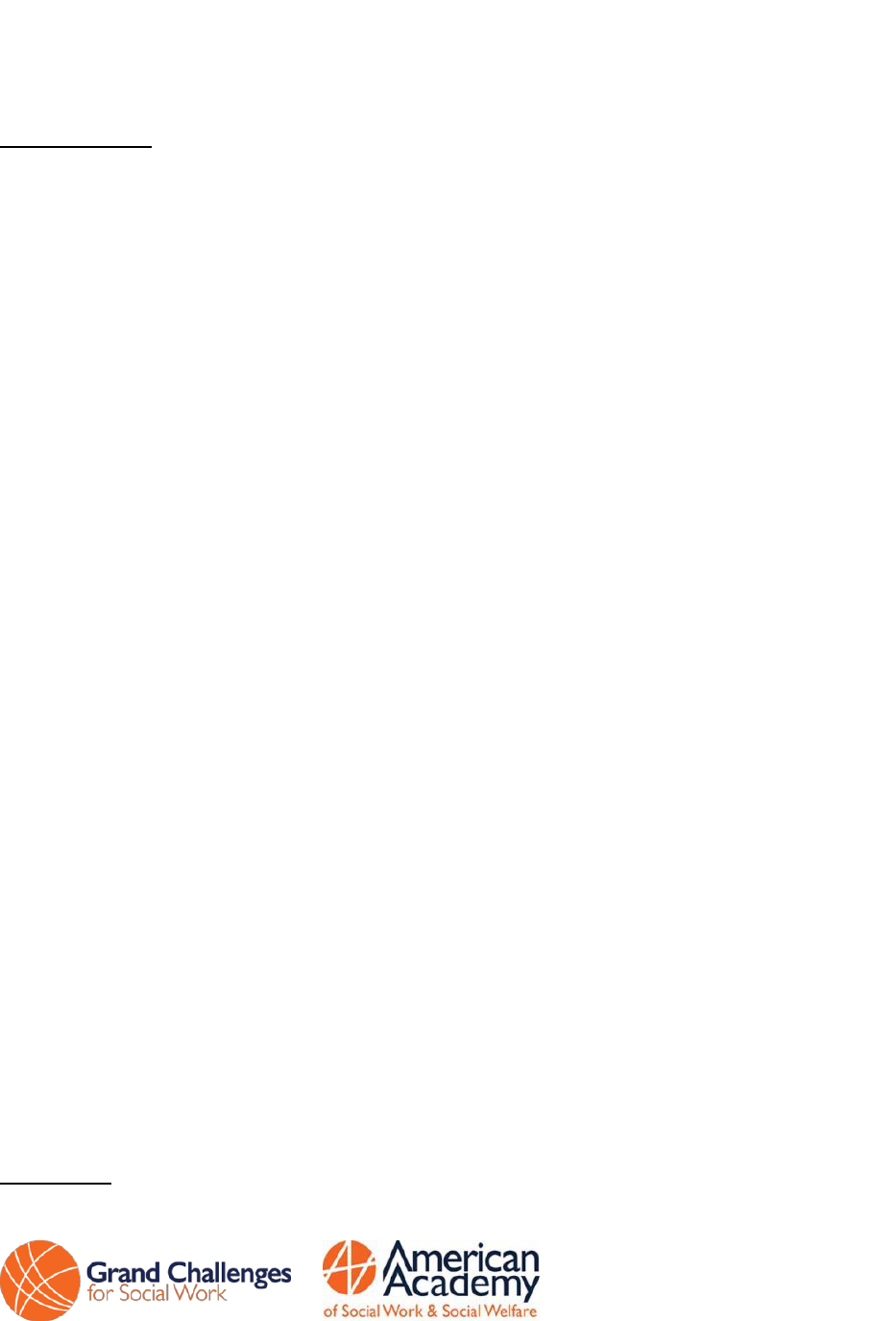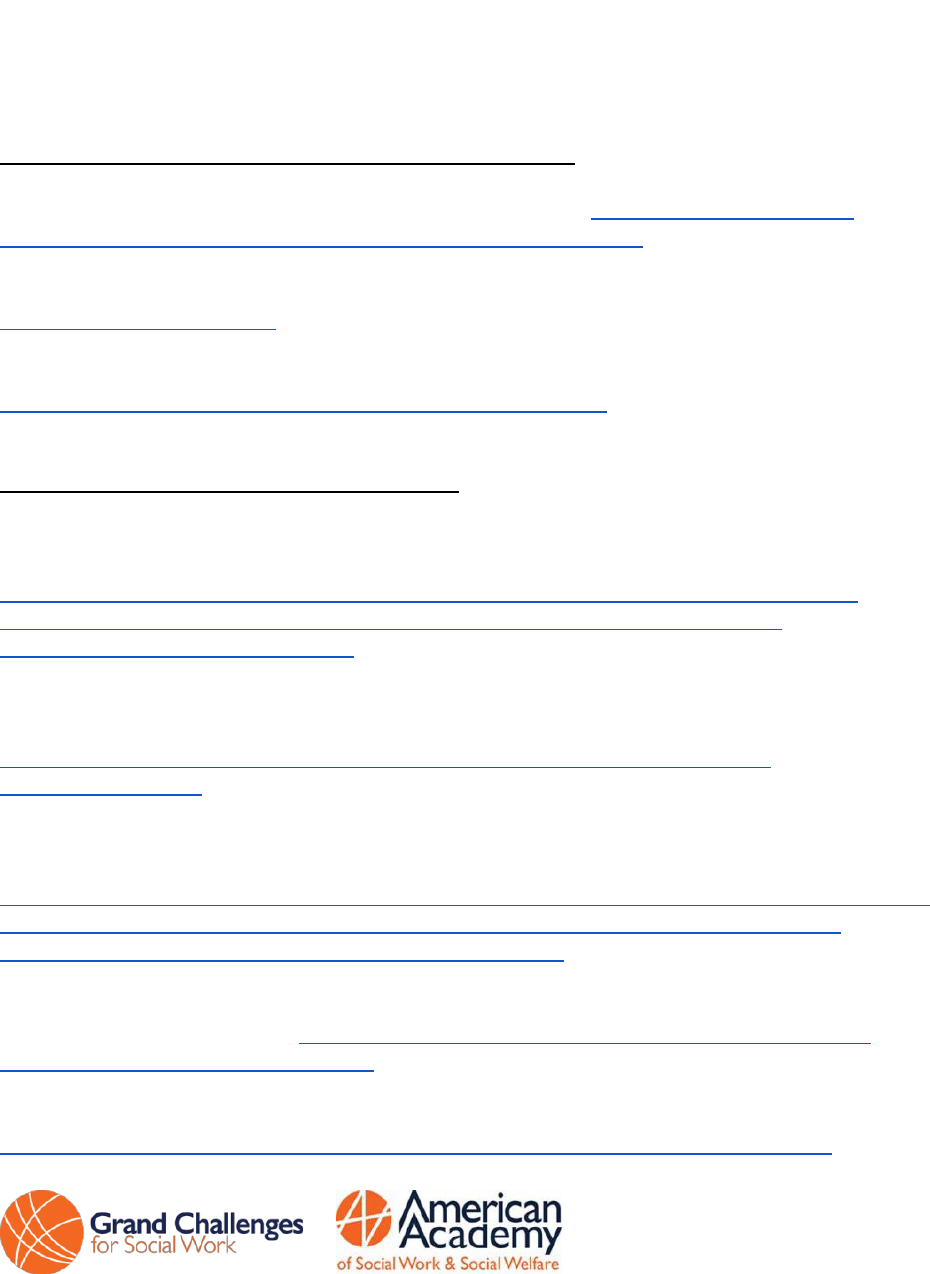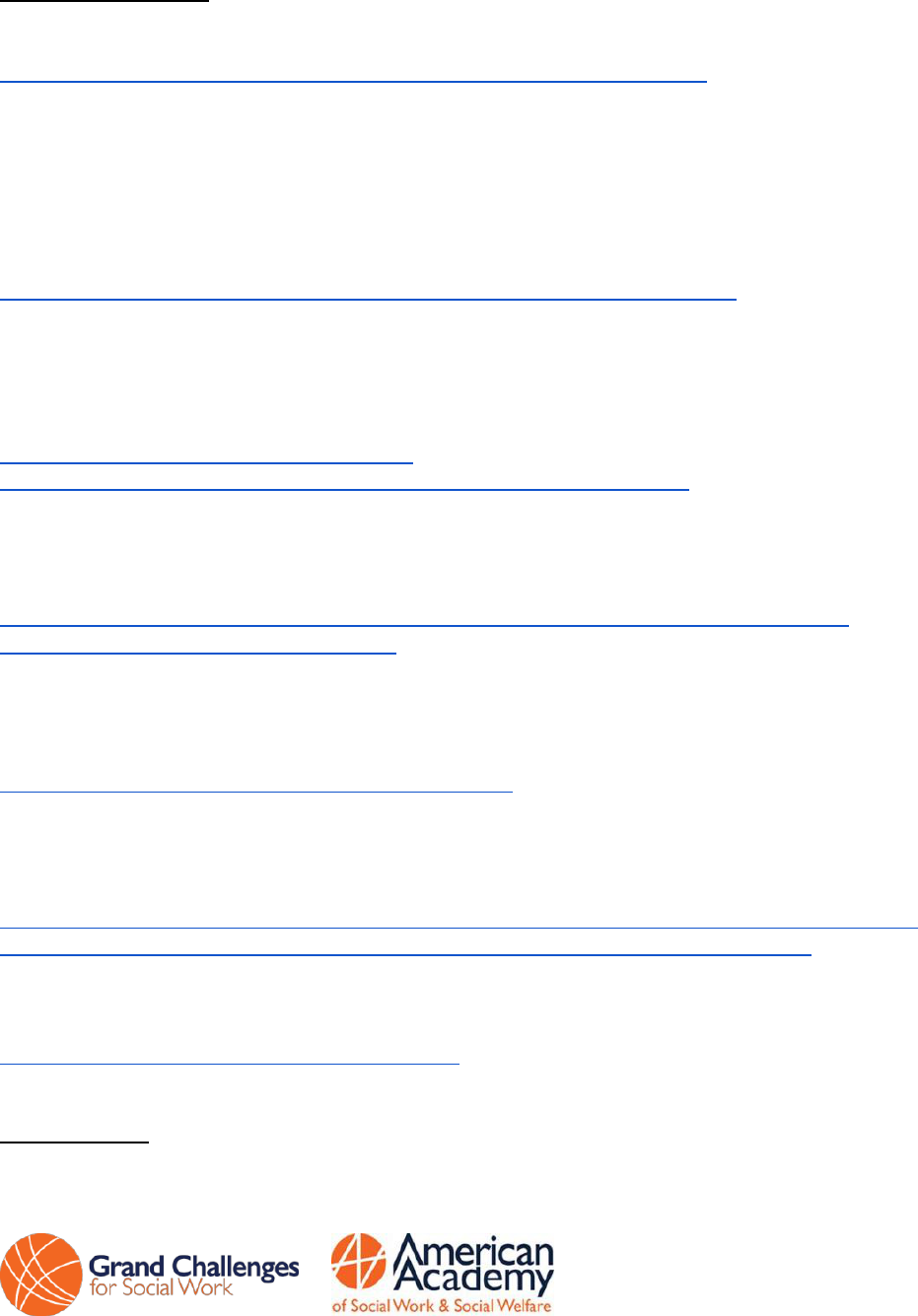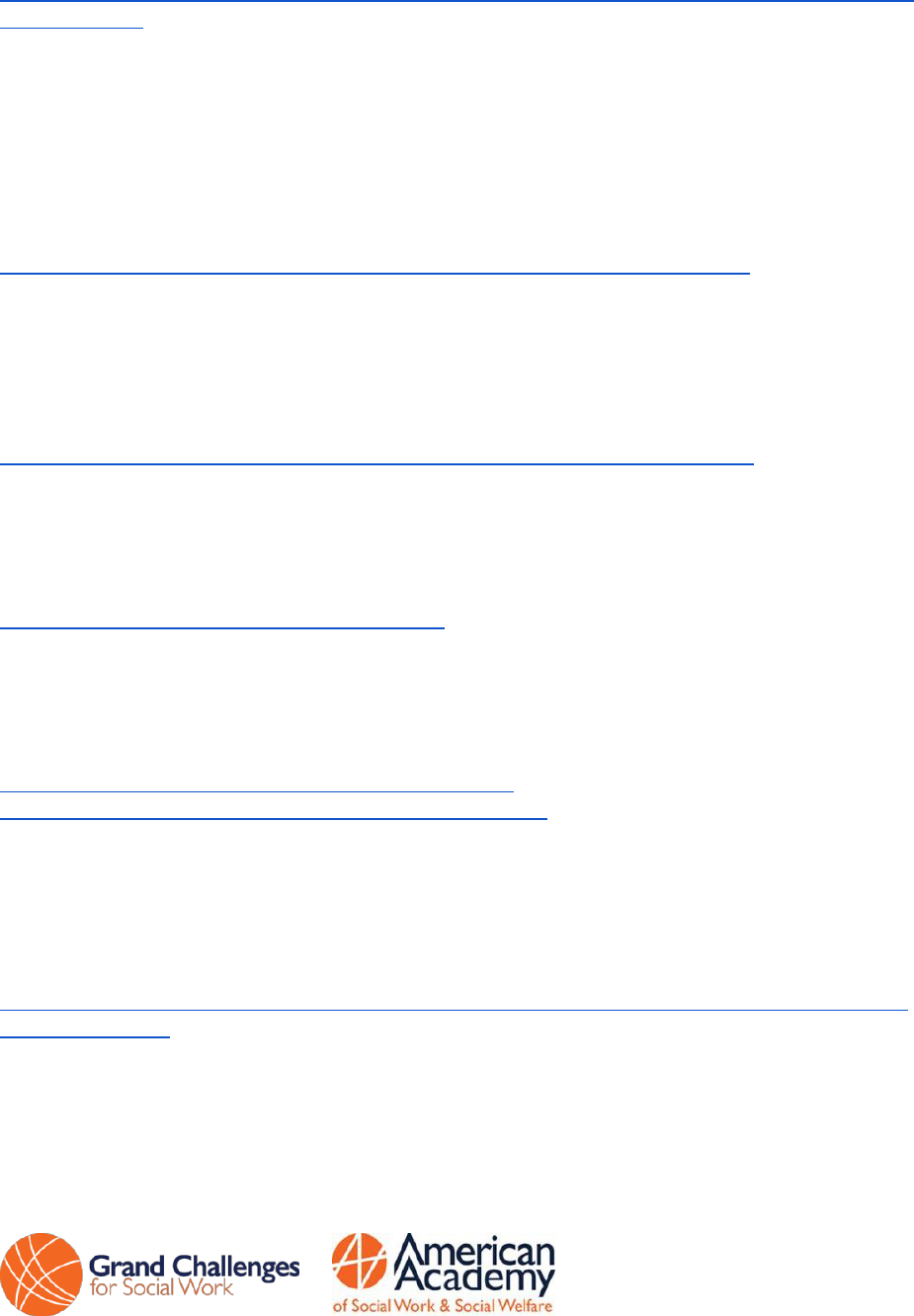
Grand Challenges Faculty Development Institute: Eradicate Social Isolation
CSWE, Dallas, TX, Oct. 19, 2017
1
Case Studies
The following case studies were included to highlight different ways that social workers
can assess and intervene with issues of social isolation. These cases are free to you to
use, modify, and incorporate into your teaching.
They include:
● The case of George, which demonstrates the need to examine our cases with
many lenses to get the whole story.
● The case of Miranda, which looks at the need for assessment of social isolation
in parents
● The case of Mr. Smith, which shows the need to assess the social support
network of caregivers.
● The case of Mary Adams and her family, which highlights the need to expand the
social network to provide more support.
● The case of Karima, which examines how clients may need to balance managing
existing supports while creating new ones.
These case studies were compiled for the Grand Challenges Faculty Development
Institute: Eradicate Social Isolation presented at CSWE, Dallas, TX, Oct. 19, 2017, and
are freely available for your use in teaching.
Presenters and collaborators: Suzanne Brown, MSW, PhD, LISW, Robert Cosby,
Ph.D., Sandra Edmonds Crewe, Ph.D., MSW, ACSW, Meredith W. Francis, MSW,
James Lubben, DSW/PhD, MPH, MSW, Michelle R. Munson, MSW, PhD, Elizabeth M.
Tracy, MSW, PHD, LISW, Adeline Wyman-Battalen, MSSW, LICSW

Grand Challenges Faculty Development Institute: Eradicate Social Isolation
CSWE, Dallas, TX, Oct. 19, 2017
2
George: Using many lenses to assess cases
George is brought to a community outpatient mental health clinic due to his parent’s
observation that he is “not acting like a normal 13-year-old.” George’s parents report
that he is failing school, has no peer group, and he is often angry at home, “lashing out
at this younger brother and sister.”
They brought him to the clinic because they think he is suffering from the same mental
illness his mother has, and the last straw was that he was found with marijuana in his
bedroom. The family reports a long and detailed family history of substance abuse. And,
they report that George’s mother lives with debilitating symptoms of anxiety and
intermittent depressive episodes.
When you talk to George, he reports “My parents are exaggerating. I have friends. And,
my little brother and sister are annoying, and are always bothering me and stealing my
stuff. Besides I prefer hanging out by myself.
Discussion:
What are some of the “lenses” that social workers can view this case?
● Medical (Mental Health and Substance-Use)
● Family context
● School context
● Structural context
● What about the social context?
○ Does that matter?
○ How
How might our treatment plans differ depending on which lens we use?
How might our interventions choices differ?
How can we maintain a focus on the social context when thinking about cases on all
levels?

Grand Challenges Faculty Development Institute: Eradicate Social Isolation
CSWE, Dallas, TX, Oct. 19, 2017
3
Miranda: Social isolation and parenting
Miranda is a 28 year old married, heterosexual woman, who comes to this family
service agency seeking support following the recent death of her mother. Miranda
complains of feeling sad every day, having difficulty sleeping and having difficulty
parenting her three children, Marta age 8, Jose age 5, and Teresa age 3. Miranda and
her family moved here from South America six years ago, as her husband found
employment with a trucking company that paid significantly more money than he could
earn in South America. Miranda’s mother moved with them and was living with
Miranda, her husband and children when she died. Miranda’s mother was diagnosed
with stage 4, metastasized lung cancer 8 months ago. Her death one month prior to
Miranda’s initial appointment was surprising to Miranda as she had hoped that the
treatment would work and would result in remission.
Miranda reports with pride that her elder daughter Marta is doing well in second grade.
She describes her as a “good girl” who helps around the house and helps Miranda care
for the younger children. Jose is currently attending pre-school. Miranda reports some
concerns about his behavior as preschool teachers have been expressing concern to
her that he may have ADHD. He is often in trouble at school, has difficulty following
directions and focusing on simple tasks such as drawing pictures and listening during
story circle. She reports that her relationship with her husband is good and that he is a
“good man”, but that he is frequently away from home due to his job, which sometimes
requires that he transport materials across the state. He is sometimes away from home
for 2 or 3 nights in a row.
Miranda presents as very sad and tearful. She is seeking some relief from her sadness
and some way to cope with the general stress of her current life circumstances.
Questions:
● Considering the context of Miranda’s life, and recent stressors, what specific
factors might place her at risk for social isolation?
● In what ways might Miranda’s social isolation compromise her parenting?
● What questions might the social worker ask Miranda in order to fully assess the
extent of her isolation? Consider the domains of parenting support that were
discussed in the presentation.
● In what ways might the social worker intervene to help decrease Miranda’s
isolation?

Grand Challenges Faculty Development Institute: Eradicate Social Isolation
CSWE, Dallas, TX, Oct. 19, 2017
4
Mr. Smith: Social support for caregivers
From: Lubben, J. E., & Gironda, M. W., (2000). Social support networks. In D.
Osterweil, K. Brummel-Smith, & J. C. Beck (Eds.), Comprehensive geriatric assessment
(pp. 121–137). New York: McGraw-Hill.
Case Vignette:
Mr. Smith, a retired federal employee, and his wife of more than forty years seemed to
be coping well on his relatively generous retirement pay and extensive health insurance
plan. For more than forty years, they lived together in a traditional blue-collar
neighborhood in a house they had inherited from Mrs. Smith's parents. The Smith's two
children both live more than 2000 miles away but regularly talk on the telephone. At
least once a year, the children along with grandchildren visit the Smiths. From all
external appearances, the Smiths are an octogenarian couple successfully aging. That
misconception was shattered late one evening when Mrs. Smith tumbled down a flight
of stairs breaking both wrists and cracking a vertebrae in her neck. The fall was partially
caused because Mrs. Smith did not want to turn on a light while she went to the
bathroom for fear that the light would awaken Mr. Smith. Given Mrs. Smith's extensive
osteoporosis, her broken wrists required extensive reconstructive hand surgery and
many weeks of hospitalization.
During Mrs. Smith's extensive hospitalization, Mr. Smith's own health problems
became more evident. His wife had concealed his increasing frailty including the fact
that he had incurred a number of falls around the house. These falls may have been
associated with a drinking problem that Mr. Smith had developed. He drank partially to
escape the loneliness brought on by his no longer being able to see friends from his
former place of employment. He was never an out-going person and seemed less so
after his retirement. Thus, he never developed new friends to compensate for those he
once had at work. When he retired from his job, he essentially retired also from his
friendship network and, overtime, developed a severe case of depression. His
increasing problem with drinking alcohol was most likely a case of self-medication.
With the deception uncovered, the Smith's two children became more involved in
monitoring their parent's situation. They also secured formal case management and
home health care services to facilitate Mrs. Smith's recovery. The children also provided
extensive periods of social support to both infirm parents during Mrs. Smith's
rehabilitation. Once she regained much of her strength, the children backed off allowing
Mrs. Smith to again resume much of the responsibility for caring for her husband.
However, children also empowered close friends and neighbors to regularly check on
the older Smith couple and to call either of the children at first sign of any difficulties.
Discussion

Grand Challenges Faculty Development Institute: Eradicate Social Isolation
CSWE, Dallas, TX, Oct. 19, 2017
5
The case of Mr. and Mrs. Smith illustrates why geriatricians, nurses, social workers and
other health care professionals all need to pay more heed to evaluating social support
networks in community health settings. Mr. Smith's symptoms of depression and
corresponding drinking problem could have probably been detected years before Mrs.
Smith's tragic fall down the stairs. Indeed, had Mr. Smith's problems been detected
earlier, many of the ensuing events may never have happened. Mrs. Smith would not
have become so burdened with caring for her husband and covering his drinking
problem. The final results demonstrated that both family and neighbor social support
networks were willing to rally around the Smiths. However, for far too long, no one
wanted to "interfere" with an elderly couple who perpetuated a myth of successful aging
when in fact they were an unnecessary accident waiting to happen.

Grand Challenges Faculty Development Institute: Eradicate Social Isolation
CSWE, Dallas, TX, Oct. 19, 2017
6
Mary Adams and her family: Expanding the social support network
The Adams family consists of Frank and Mary (the parents) and two teenaged children,
Julie and Bill. The family was referred by CPS when Julie ran away from home following
an argument with her mother over chores which resulted in a beating from her father.
Confrontations over non-compliance with house rules and non-participation in church
activity have escalated over the past year. Frank and Mary are heavily involved in their
church, which has rules about how members should dress. They attend church
meetings four days a week. Julie and her parents have major conflicts over these rules.
While assessing the family’s social support network, you discover it consists almost
exclusively of church contacts. Mary’s network consists of five people, including Frank,
Julie, Bill, her pastor, and her pastor’s wife. The family has just moved to an apartment.
They know no one in the building. Mary agrees to work with you on expanding her
social support network.
Discussion:
● Brainstorm ways in which you might help Mary expand her social support
network.
● What skills might you teach her to enable her to expand her network?
● What might be an appropriate homework assignment?
● What might be a reasonable goal?

Grand Challenges Faculty Development Institute: Eradicate Social Isolation
CSWE, Dallas, TX, Oct. 19, 2017
7
Karima: Creating new supports and managing existing ones
Karima is the mother of a 4-year-old boy, Jamal, who is enrolled in Head Start. Karima,
27 years old, is a single parent, living with her mother and brother. She attends a
community college part-time, where she is studying early childhood education. Her
network consists of:
● Karima’s mother, who helps with child care and housework, but is sometimes
critical of Karima’s ability to be a parent to Jamal.
● Jamal, her son, who is an active child, but also lots of fun.
● Karima’s brother, who helps with transportation from time to time.
● Jamal’s father, who is only seen infrequently, but who provides child support.
Sometimes Karima and Jamal’s father argue over how to handle Jamal.
● Head Start personnel (mainly the teacher and parent advisor), who have helped
Karima deal with Jamal’s behavior and helped her learn about community
resources.
● Karima’s teachers and classmates at the community college, who are helpful, but
not very close.
● Imams and members of Karima’s mosque.
Karima has clearly defined the following two goals for her support network:
1. She would like to get to know some of her classmates better at school. That way,
if she had to miss class, she would have people to rely upon for notes. She
doesn’t have a lot of time to socialize when she gets to school, though.
2. She would also like to handle her mother’s criticisms of her in a better way. She
gets angry when her mother criticizes her, but she knows she needs to rely on
her mother’s help with Jamal.
Discussion
● What skills might Karima need to learn to reach her goals?
● What is a reasonable first step for Karima to take to reach each goal?
● Draw a simple ecomap, indicating the strength or weakness of relationships,
direction of support, and relationships with tension or conflict.
While Karima has already formulated her goals, ecomaps can be an effective,
collaborative tool for clients to identify strengths and weaknesses in their network. What
strengths and weaknesses do you see in Karima’s ecomap?

Grand Challenges Faculty Development Institute: Eradicate Social Isolation
CSWE, Dallas, TX, Oct. 19, 2017
8
The materials presented in this resource list were compiled to supplement and support
the Faculty Development Institute on the Eradicate Social Isolation Grand Challenge
presented at the CSWE 2017 APM in Dallas, TX, on October 19th.
Presenters and collaborators for this Institute are as follows:
Suzanne Brown, MSW, PhD, LISW, Robert Cosby, Ph.D., Sandra Edmonds Crewe,
Ph.D., MSW, ACSW, Meredith W. Francis, MSW, James Lubben, DSW/PhD, MPH,
MSW, Michelle R. Munson, MSW, PhD, Elizabeth M. Tracy, MSW, PHD, LISW, Adeline
Wyman-Battalen, MSSW, LICSW
General Resources on Eradicating Social Isolation
Eradicate Social Isolation Grand Challenge website http://aaswsw.org/grand-
challenges-initiative/12-challenges/eradicate-social-isolation/
Social Isolation: Effects and Solutions (AARP)
https://connect2affect.org/
Online learning module on Social Isolation
http://www.bc.edu/centers/ioa/videos/social-isolation.html
Eradicating Social Isolation in the Media
McGregor, J. (2017, October 4). This former surgeon general says there’s a ‘loneliness
epidemic’ and work is partly to blame. The Washington Post. Retrieved from
https://www.washingtonpost.com/news/on-leadership/wp/2017/10/04/this-former-
surgeon-general-says-theres-a-loneliness-epidemic-and-work-is-partly-to-
blame/?utm_term=.17f47db47fa9
Brody, J. E. (2017, June 13). Social interaction is critical for mental and physical health.
The New York Times. Retrieved from
https://www.nytimes.com/2017/06/12/well/live/having-friends-is-good-for-
you.html?mcubz=0
Zaraska, M. (2016, September 4). Loneliness can be depressing, but it may have
helped humans survive. The Washington Post. Retrieved from
https://www.washingtonpost.com/national/health-science/loneliness-can-be-depressing-
but-it-may-have-helped-humans-survive/2016/09/02/c01a15f4-38a0-11e6-8f7c-
d4c723a2becb_story.html?utm_term=.f0234bd97e25
Hafner, K. (2016, Sept 5). Researchers confront an epidemic of loneliness. The New
York Times. Retrieved from https://www.nytimes.com/2016/09/06/health/lonliness-
aging-health-effects.html?mcubz=0
Resnick, B. (2017, January 30). Loneliness actually hurts us on a cellular level. Vox.
https://www.vox.com/science-and-health/2017/1/30/14219498/loneliness-hurts

Grand Challenges Faculty Development Institute: Eradicate Social Isolation
CSWE, Dallas, TX, Oct. 19, 2017
9
Assessment Tools
Lubben Social Network Scale (Lubben & Gironda, 2003; 2004)
http://www.bc.edu/schools/gssw/lubben/description_of_thelsns.html
There are three versions of the LSNS:
LSNS-R (12 items; revised version of the original scale)
LSNS-6 (brief, 6-item scale; best for clinical use)
LSNS-18 (18 items; expanded version for research)
The three versions of the LSNS are freely available to use and available for download
through the link above. If you are using the scale for research purposes, please
complete the form available here:
http://www.bc.edu/schools/gssw/lubben/permission_to_usescales.html
Berkman-Syme Social Network Index
A self-report scale for adults designed to to assess the type, size, closeness, and
frequency of contacts in a respondent’s current social network. More information
regarding this scale is available here:
https://www.phenx.org/Portals/0/phenx-
content/consensus/social_environments/18a_SocSupport-SNI.pdf
Parent’s Assessment of Protective Factors Scale
This scale is designed to assess 5 protective factors for parents, including their social
connectedness and social support. The instruction manual and scale are available here:
https://www.cssp.org/reform/child-welfare/pregnant-and-parenting-youth/Parents-
Assessment-of-Protective-Factors.pdf
Multidimensional Scale of Perceived Social Support (Zimet, Dahlem, Zimet, &
Farley, 1998)
A brief, 12-item measure, valid and reliable for youth. Available here:
http://www.yorku.ca/rokada/psyctest/socsupp.pdf
The UCLA Loneliness Scale (Revised) (Russell, 1996)
The full, 20-item measure, scoring instructions, and a brief overview of the measure are
available here:
http://fetzer.org/sites/default/files/images/stories/pdf/selfmeasures/Self_Measures_for_L
oneliness_and_Interpersonal_Problems_UCLA_LONELINESS_REVISED.pdf
Egonet computerized social network software
Free software that allows you to measure and visualize egocentric social networks.
https://sourceforge.net/projects/egonet/files/
Interventions
Mentoring for Youth with Mental Health Challenges

Grand Challenges Faculty Development Institute: Eradicate Social Isolation
CSWE, Dallas, TX, Oct. 19, 2017
10
A comprehensive review of the literature regarding this issue, including practical points
for clinicians. Available here:
http://www.nationalmentoringresourcecenter.org/images/PDF/Mental_Health_Populatio
n_Review.pdf
Premature Baby Positive Parenting Program
The Premature Baby Positive Parenting Program (aka “Triple P”) is a program designed
to support parents of premies, help them build relationship skills to maintain their
relationships with their partners and child, and reduce the isolation that many new
parents of premies feel. Without intervention, this social isolation and lack of support is
related to long-term developmental and behavioral problems for the child. An overview
of the program is available here:
http://www.triplep.net/glo-en/find-out-about-triple-p/triple-p-in-a-nutshell/
Strengthening Families Protective Factors (Center for the Study of Social Policy)
This is an agency-wide program designed to help families on multiple levels. Of
particular interest to the Eradicate Social Isolation Grand Challenge, one of the
protective factors is to improve the social connections for the family. Learn more about
this program here:
https://www.cssp.org/young-children-their-families/strengtheningfamilies
Campaign to End Loneliness - Connections in Older Age
A network established in the United Kingdom of national, regional and local
organizations and people working together through community action, good practice,
research and policy to to ensure that loneliness is acted upon in the UK as a public
health priority at national and local levels.
https://www.campaigntoendloneliness.org/
Buddy Benches
Nearly 2,000 “buddy benches” have popped up at schools around the US as a place
where kids can go when they're feeling lonely and need a friend. This simple, school-
wide intervention helps school age children deal with isolation on the playground.
https://www.youtube.com/watch?v=iVWp4j3f2UY
https://www.youtube.com/watch?v=Ob2OsHYQ7PM
Empathy Cake
A Danish tradition in primary schools is to have time set aside each week to share a
treat and build relationship and empathy skills. This intervention emphasizes that
empathy and the ability to form and maintain relationships are learned skills, not innate
traits.
http://www.salon.com/2016/08/09/teaching-kids-empathy-in-danish-schools-its-well-its-
a-piece-of-cake/

Grand Challenges Faculty Development Institute: Eradicate Social Isolation
CSWE, Dallas, TX, Oct. 19, 2017
11
The materials presented in this reference list were compiled to supplement and support
the Faculty Development Institute on the Eradicate Social Isolation Grand Challenge
presented at the CSWE 2017 APM in Dallas, TX, on October 19th. Presenters and
collaborators for this Institute are as follows:
Suzanne Brown, MSW, PhD, LISW, Robert Cosby, Ph.D., Sandra Edmonds Crewe,
Ph.D., MSW, ACSW, Meredith W. Francis, MSW, James Lubben, DSW/PhD, MPH,
MSW, Michelle R. Munson, MSW, PhD, Elizabeth M. Tracy, MSW, PHD, LISW, Adeline
Wyman-Battalen, MSSW, LICSW
Reference List
Fantuzzo, J., Stevenson, H., Kabir, S. A., & Perry, M. A. (2007). An investigation of a
community-based intervention for socially isolated parents with a history of child
maltreatment. Journal of Family Violence, 22(2), 81-89.
Lubben, J., Gironda, M. (2004). Measuring social networks and assessing their benefits.
In Social networks and social exclusion: Sociological and policy perspectives. Eds.
Phillipson, C., Allen, G., Morgan, D. Burlington, VT: Ashgate.
Lubben, J., & Gironda, M. (2003). Centrality of social ties to the health and well-being of
older adults. In Social work and health care in an aging society: Education, policy,
practice, and research. Eds. Berkman, B., Harootyan, L. New York: Springer.
Moore, M. (2003). Socially isolated? How parents and neighbourhood adults influence
youth behaviour in disadvantaged communities. Ethnic & Racial Studies, 26(6), 988-
1005.
Munson, M. R., & Railey, J. (2016). Mentoring for youth with mental health challenges.
National Mentoring Resource Center. Available online
http://www.nationalmentoringresourcecenter.org/images/PDF/Mental_Health_Populatio
n_Review.pdf
Nowak, C. & Heinrichs, N. (2008). A comprehensive meta-analysis of Triple P - Positive
Parenting Program using hierarchical linear modeling: Effectiveness and moderating
variables. Clinical Child and Family Psychology Review, 11, 114-144.
Russell, D. (1996). UCLA Loneliness Scale (Version 3): Reliability, validity, and factor
structure. Journal of Personality Assessment, 66, 20-40.
Zimet, G. D., Dahlem, N. W., Zimet, S. G., & Farley, G. K. (1988). The multidimensional
scale of perceived social support. Journal of Personality Assessment, 52(1), 30-41.
doi:10.1207/s15327752jpa5201_2
